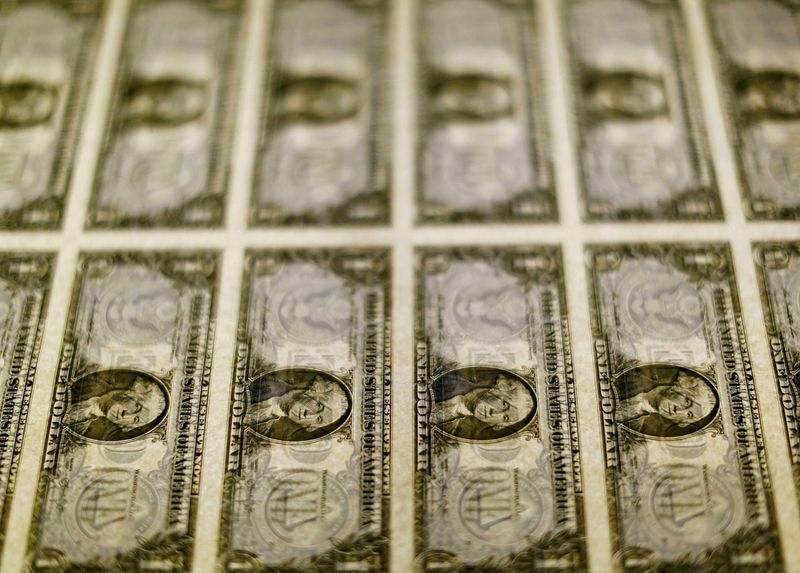By Jamie McGeever
ORLANDO, Florida (Reuters) - The dollar has been floored by an aggressive repricing of the U.S. interest rate outlook, but it's likely too soon to count the greenback out.
The dollar is currently languishing at its weakest level of the year against baskets of major and emerging market currencies, which raises the question: Can this bearish momentum be sustained?
Looked at through the lens of relative interest rates, the answer is almost certainly "no." The depth and speed of Fed easing now priced into the U.S. futures curve looks overdone, on an absolute basis and especially in relative terms.
Traders are now anticipating more than 200 basis points of Fed rate cuts by September 2025, and the fed funds rate reaching its so-called terminal level just above 3.00% the following year.
This assumes that the Fed will pursue comfortably the most aggressive policy-easing campaign among the G7 countries.
Traders are also pricing in a one-in-three chance that this easing cycle kicks off with a 50 bps cut next month. In the history of the modern Fed, such a large initial cut has only ever happened in emergencies and crises.
To be sure, U.S. markets have just suffered a huge volatility shock, and large downward revisions to employment growth suggest the labor market is creaking. So it is possible that markets are more fragile than previously thought.
But it would probably take much more than a modest slowdown to justify the scale of easing traders now expect.
IT'S ALL RELATIVE
As the saying goes, if the U.S. sneezes, the rest of the world catches a cold. But rates traders seem to be assuming that the rest of the world has developed some immunity to U.S. weakness.
While other major central banks like the Bank of Canada, Bank of England and European Central Bank have already begun cutting rates, their projected rate paths are shallower than the Fed's. In some cases, significantly so.
The BOC is expected to cut a further 180 basis points, the ECB 165 bps, the BoE 135 bps, the Reserve Bank of Australia 100 bps and the Swiss National Bank 60 bps, based on their respective policy rates and implied terminal rates.
If these assumptions are already reflected in the dollar's price, then further dollar weakness will require that the U.S. economic outlook become gloomier and that this shade somehow fails to spread over other countries and currencies.
As George Saravelos, head of FX research at Deutsche Bank, points out, the U.S. economy continues to grow at a decent clip relative to its major rivals: The euro zone is flirting with stagnation, and China is flirting with deflation.
"We see a far shallower U.S. easing cycle than priced. The risks seem skewed toward a more hawkish Fed," Saravelos says.
KEEPING IT REAL
A look at annual inflation rates across G7 countries shows central banks' 2.00% targets are within reach. But even though the Fed can allow itself a much-deserved pat on the back, inflation is higher in the U.S. than in any other G7 economy, by some measures.
This could still limit the scale and speed of policy loosening, and thus lift the dollar off its 2024 lows.
True, "real" U.S. interest rates are high and have plenty of room to fall as growth slows. Factoring in annual CPI inflation, the real federal funds rate is approaching 3.00%, the highest since 2007.
Eurizon SLJ Asset Management's Stephen Jen is one of many analysts who believe historically high real rates will allow the Fed to go big in its easing. In which case, the dollar's current weakness is justified.
"There will be a time when the market will overshoot again in pricing in too much too soon, but my guess is that we are not there yet," Jen says.
But even if one agrees that today's expected trajectory for interest rate cuts could materialize, that's already priced in. It's tough to imagine we could see greater easing, barring a true crisis.
And, again, one has to ask what will happen elsewhere. Real interest rates in other countries are also at their highest levels since the global financial crisis. Granted, many are lower than the U.S. rate, but some, like the BoE's "real" rate, are on a par.

Forecasting currency movements may be akin to a coin toss, as former Fed Chair Alan Greenspan once observed, so one should have some humility when doing so. But it's safe to assume that if the Fed cuts more slowly than expected, the dollar will get back off the ropes and fight back.
(The opinions expressed here are those of the author, a columnist for Reuters)